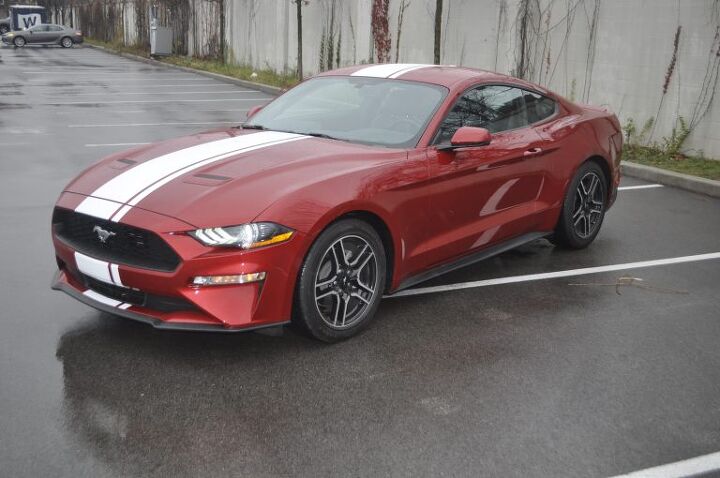2020 Ford Mustang EcoBoost Premium Review - A Potent Pony at A Bargain

2020 Ford Mustang EcoBoost Premium Fast Facts
Let’s say you’re in the market for a Ford Mustang. Let’s say you like to drive fast and like cars that handle well, so the venerable pony car is on your radar. Let’s also say that when you sit down at your laptop and start playing with the consumer website’s build and price feature and you see that a well-equipped GT quickly busts your budget, you trudge off to the fridge to drown your sorrows in adult beverages while you question every life decision you’ve ever made that left you in such a financial state that a V8 pony car is unattainable.
Well, you can cheer up, at least a little. The V8 experience is available to you for less money IF you can sacrifice the soundtrack and live with half the cylinders.
That’s right – the Mustang EcoBoost gets you all of the Mustang experience, good and bad, for fewer dollars and with only a mild performance penalty.
You even get, if you so choose, the option to row your own.
That “good and bad” from above shouldn’t be overlooked. Just like its V8 brethren, the EcoBoost Mustang provides grins but with more than a few tradeoffs.
Let’s start with the good. The 2.3-liter, twin-scroll turbocharged four-cylinder puts out 310 horsepower and 350 lb-ft of torque (an optional Performance Package, which my test car did not have, bumps the horsepower number to 330), and that’s plenty to get this car motivated quite nicely, though without that soul-satisfying V8 rumble. There’s also not quite as much grunt as would be offered by twice the cylinder count, though the max torque that is on hand is accessible at just 3,000 rpm.
Meanwhile, the six-speed Getrag gearbox is fun to row, and the clutch offers nice engagement and smooth take-up. You also get respectable EPA fuel-economy numbers.
Even without the available Handling Package (requires the Performance Package), the EcoBoost ‘Stang is a hoot in the corners, though you don’t forget it’s a rear-drive car with torque on tap and a long hood/short deck layout.
Then there’s the bad. While no one expects a Mustang to have a roomy rear seat, the backseat in this car barely functions as more than a fancy parcel shelf. Similarly, no one expects a Mustang to ride silky smooth, but even now that the Mustang has an independent rear suspension, it still shakes and shimmies over expansion joints as if it were a club kid who just sampled some candy of the nose.
And when it’s not boogying, it’s riding stiffly. A magnetic-ride system is available, but say it with me now: It requires the Performance Package.
Not to mention that while the EPA fuel-economy numbers are solid, the real-world numbers are not quite as good, especially if you decide to have a bit of fun.
Other aspects of our base-model-bargain pony car are mixed. For example, the interior. The good news is that the controls are easy to use – whether that’s all because of the logical layout and/or because of familiarity is harder to answer. The bad news is that the cabin is starting to look a bit too familiar.
Notable standard features included capless fuel-filler, dual exhaust, LED fog lamps, LED headlights and taillights, digital gauge cluster, interior ambient lighting, dual-zone climate control, USB, leather-trimmed seats, keyless entry and starting, wi-fi, limited-slip rear axle, satellite radio, track apps, and Sync infotainment.
My test car was optioned with navigation, blind-spot information, 18-inch wheels, spoiler, and racing stripe. Out the door for under $36K.
That may not sound like a bargain on the face of it, but it’s below both the starting price of a base GT and the average new-car transaction price.
You don’t get a V8’s rumble and low-end grunt, but you still get a sports car that’s reasonably fun to drive. Yeah, we still prefer the GT, but this bargain is hard to argue with.
What’s New for 2020
New for 2020 is the available High Performance Package.
Who Should Buy This Car
The Mustang buyer who can’t afford a V8.
[Images © 2021 Tim Healey/TTAC, Ford]

Tim Healey grew up around the auto-parts business and has always had a love for cars — his parents joke his first word was “‘Vette”. Despite this, he wanted to pursue a career in sports writing but he ended up falling semi-accidentally into the automotive-journalism industry, first at Consumer Guide Automotive and later at Web2Carz.com. He also worked as an industry analyst at Mintel Group and freelanced for About.com, CarFax, Vehix.com, High Gear Media, Torque News, FutureCar.com, Cars.com, among others, and of course Vertical Scope sites such as AutoGuide.com, Off-Road.com, and HybridCars.com. He’s an urbanite and as such, doesn’t need a daily driver, but if he had one, it would be compact, sporty, and have a manual transmission.
More by Tim Healey
Latest Car Reviews
Read moreLatest Product Reviews
Read moreRecent Comments
- Bd2 There's nothing wrong with admitting there is a problem yet that is but the first step. Hopefully GM can resurrect their vaunted hybrid technology and apply it to high value luxury vehicles and perhaps give the world a revival of that V Magic. They could even give Genesis a run for it's crosshatched grille money.
- TMA1 Tell me the ICE version is going to weigh less. A 5,800 lb electric Charger just took the worst part of the old Charger and made it 30% heavier.
- Danddd Just say no to CVTs unless you like the sound of droning.
- Oberkanone GM will have 30 EV models by 2025. Over 40% of GM sales will be EV by 2025.quote - Marry Barra circa 2020Including 4 Chevy EV, 2 Buick EV, and 4 Cadillac EV.
- Dwford There's plenty of time between now and 2030-35 to design and sell through a whole new generation of ICE vehicles, if not 2 generations. Chevy seems to be on a dual track plan with ICE and EV versions of the Equinox and Blazer nameplates. No reason Cadillac can't do something similar.







































Comments
Join the conversation
Will be in the market for a convertible Stang or Camaro in the near future. Having driven my Mustang loving buddies 2 2015 Stang convertibles, one with the 3.7 V6 and the current 2.3 EB I would prefer the former. The 2.3 Eb is a fussy noisy unpleasant sounding lump that really doesn't provide little if any advantage in power over the smoother more livable V6. It also requires premium fuel to get that 310 HP rating which the V6 doesn't. My friend uses 87 octane gas due to the fact premium is almost 4 bucks per gallon so the turbo 4 seems about even powerwise if the two cars were drag raced. The 2.3 has also suffered some oil burning issues with under 100K on the clock, needed the upper portion of the engine re-sealed and has always suffered a cold idle shake that can be felt through the steering wheel. I haven't driven a newer 2018-current 2.3 EB with the 10 speed but have read that it takes some getting used to odd shifting behavior. This is one area where I like the Camaro better. I can get GM's excellent 335 HP 3.6 tied to the equally excellent 10 speed auto and have a near perfect powertrain. The slightly tighter feel and bunker windows are a turn off but the convertible fixes that during the Summer months. Decisions decisions.
No skin in the game whatsoever as i think the mustang and camaro are both on borrowed time but.... what's the weight diff between the turbo i4 or v6 vs the v8 and what's the fuel economy numbers anyways? and 2) damn... you mustang fanbois are really into the GT! please don't bother to flame about this as like i said, i don't really care either way as this car is impractical for me and always will be but after reading waaaay too many comments about this i didn't see anything about weight.. and weight is only counteracted by more power, which begets more brakes, suspension, wheels, cooling, fuel consumption etc. so i'd go for lighter anytime. maybe i'm just getting old?